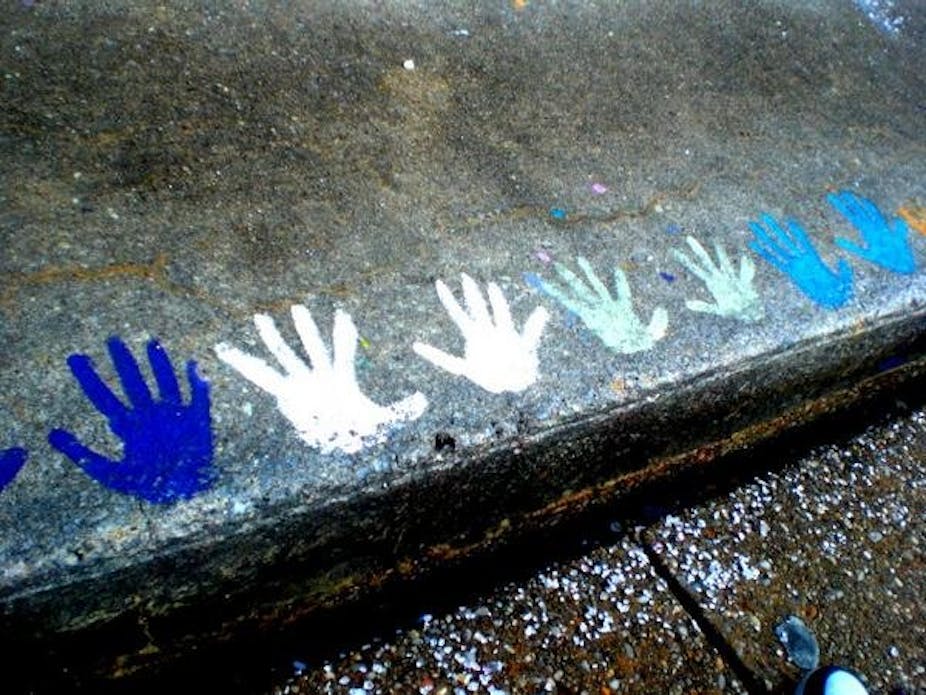This week, The Australian reported that a hand stencil found in a controversial coal mining development in the Blue Mountains was a “fake”. The story has also been reported by the BBC and was picked up by Andrew Bolt at the Herald Sun.
Community concerns have been high about this development. The extension of the mine, near the Garden of Stones area, has reportedly attracted over 500 objections. When the stencil was discovered earlier this year, local environmentalists redoubled their opposition to the development. The hand stencil was not found during an initial archaeological survey for an Environmental Impact Assessment in 2011 and, according to the engineering consultancy Aecom Australia contracted by the miner Coalpac, it cannot be authentic.
On the face of things, a complex set of environmental planning processes were put in train – and late in the day an item of supposedly Aboriginal heritage has been found, introducing uncertainty into the approvals process.
Is it possible that the hand stencil is a fake? After all, that would require someone to have gone to a remote cave in a dense forest in the centre of the proposed development footprint to create a piece of “fake” rock art – hoping that it would halt or delay the development’s approvals process.
And could a single hand stencil really stop a coal mine?
How is rock art authenticated?
The stencil is described in Annabel Hepworth’s article for The Australian as “not genuine” and as being a “modern replica” of a traditional Aboriginal hand stencil; not having “thick and easily observable pigment” and being affected by water run-off so unlikely to have survived for any length of time.
The archaeological consultants also note that other rock art sites in the area have red ochre hands stencils, not white ones. The stencil was found by someone from a local action group doing a vegetation survey – a factor which appears to have had some bearing on the perception of the authenticity of the find.
I do not know any more details about this specific case than those provided in The Australian – which includes a photograph of the “controversial hand stencil” – but I have been recording rock art in the Sydney region for over 30 years.
Would a recent stencil be protected under the NSW National Parks and Wildlife Act? Well, yes. The Act protects all Aboriginal objects (as defined) as long as they are not “a handicraft made for sale”. All objects are protected – whether made before or after New South Wales was settled/ invaded by people of British heritage (and all subsequent).
So, if it could be demonstrated that the art was produced since the archaeologists first visited the site, the question might be: was it made by an Aboriginal person as part of an “authentic” tradition?
Heritage is an ongoing and living thing that does not reside only in the past. However, no member of the local Aboriginal community has as yet come forward to suggest this is the case.
What an archaeological survey might miss
From my experience, I know that it is often difficult to see Aboriginal rock art during a single visit to a site. Motifs created with white pigment (usually a clay, kaolinite) especially during wet conditions, are notoriously difficult to see.
Earlier this year I went back to an art site in the Western Desert that I have visited four times over the last ten years.
In that cave on this visit we found six hand stencils amongst a rich painting assemblage which had not been seen on previous visits. This year has been a particularly dry one in the Ranges, and I observed that the white pigment (paintings and drawings) in all sites looked “brighter” than previously observed. I certainly did not conclude that these six “new” hand stencils were new: I know that I just didn’t see them on previous visits.
What happens when rock art is discovered?
So what is the usual management procedure taken by the regulators in protecting any Aboriginal sites in NSW? Would a single hand stencil ever stop a coal mine? Probably not.
It would be rare for any Aboriginal site to stop a development in NSW if it were not deemed to be culturally or scientifically significant. A single hand stencil would rarely be assessed as having high significance: unless perhaps it was done by a known significant Aboriginal person during a significant historic event. Or, if it was the only white hand stencil in a region where all the other recorded hand stencils were red!
All heritage is important. A single hand stencil tells us certain things at the small-scale intimate (individual) level; while “big” complex sites give us different kinds of information about sites which have been used by groups intensively – or over long periods of time.
The NPW Act manages Aboriginal heritage and there are multiple issues to be considered in every decision made. Authenticity is an important consideration in assessing significance. Managing Aboriginal heritage is a complex process, and it requires archaeologists to be competent, consistent and confident in their assessment processes.

